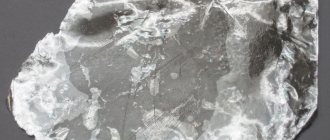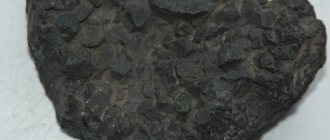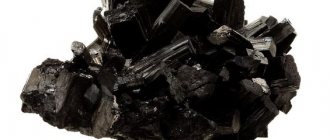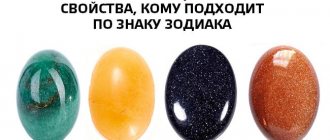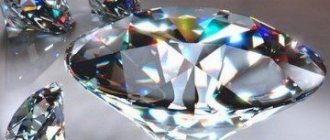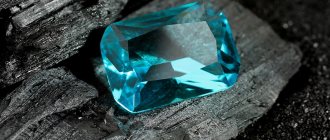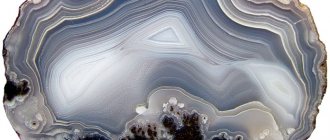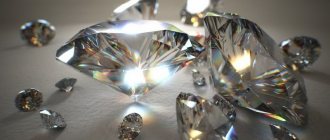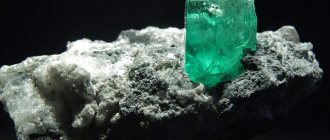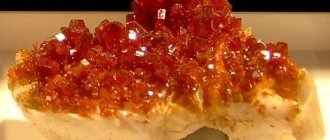What does it represent?
The structure of the mollusks resembled squids, but the rostrum shell in which the body was hidden was more powerful. The huge number of shells in the Jurassic layers may indicate that they led an active lifestyle, and how the squid moved in huge schools.
Scientists who first discovered the mineral mistook it for arrowheads, and therefore gave it the name “belemnite,” which in Greek means “throwing projectile” or “dart.”
Devil's Finger stone can be found in sedimentary marine and marble rocks that formed millions of years ago. Rostras have a wide range of colors and shades from gray to yellow, and from light brown to cherry. Their length reaches 30-45 cm. The shells are distinguished by an alluring glass luster, similar to crystalline.
Therapeutic effect
Traditional healers do not doubt the magical capabilities of belemnite.
Why is the mineral useful?
Skeptics consider the healing properties of belemnite to be “advertising,” but official medicine confirms them. And it links the influence of the stone on the human body with the composition and time of formation.
Millions of years ago, there was ecological “sterility” on Earth: there was no talk of any chemicals, exhausts, or other environmental pollutants.
The basis of the stone is calcium and aragonite. This tandem is useful for problems with bones (osteoporosis, chondrosis, fractures) and skin.
What and how to treat belemnitis
The healing properties of fossils can solve the following problems:
- dermatitis;
- diabetes;
- gastritis;
- bleeding;
- tuberculosis;
- ARZ, ARVI.
Belemnite powder quickly stops bleeding. The wound will also heal quickly.
There are different ways to use stone in medicine:
- Lotions with powder are applied to inflamed areas of the skin.
- Boils, psoriasis, dermatitis are sprinkled with fine powder. Relief occurs after several procedures.
- A healing infusion of herbal powder is used for baths, applications to the skin, and rinsing hair after washing.
- Chinese and Tibetan healers have a special regard for the devil's finger mineral from clay deposits. Traditional medicine recommends adding the powder to drinks as a general tonic.
Mineral raw materials should not be filled with very hot water (especially boiling water). Only good warm.
Beauty sphere
In cosmetology, the stone is used to improve skin health:
- It is cleansed at deep levels, saturated with microelements, which belemnite is rich in.
- As a result, metabolism is activated. The skin becomes clean, elastic, looks young and radiant.
- The procedure is effective for swelling and inflammation of the skin.
This effect is especially relevant for fading, faded, problematic, acne-prone teenage skin.
Contraindications
Belemnite preparations are effective, but not universal. Use is prohibited or requires caution in the following cases:
- pregnancy;
- lactation;
- thrombophlebitis in acute form;
- urolithiasis or the risk of its occurrence;
- hypertension;
- recent heart attack.
If there are contraindications, you should consult with your family or attending physician.
Legends about the mineral
Rhomboteuthis lehmani
“Devil's finger” has evoked two feelings in people since ancient times - reverence and fear.
According to legend, the devil, who desired to gain immense power over humanity, was defeated by good forces and turned into stone. Belemnites, also called "devil's claw", are believed to be the remains of his fingers, scattered throughout the world.
The ancient Slavs believed that belemnites were arrows fired by Perun the Thunderer. For this reason the stone was called “thunder arrow”.
In Eastern countries, the mineral was called “dragon’s teeth” and “cow’s teats” due to its external similarity.
Varieties of mineral
Devil's Claw is a stone that has different types. The classification is based on color, which depends on impurities.
The following belemnite rostra are found in nature:
- Rust-brown - they contain iron. Its amount is usually no more than 4%. Sometimes the impurity forms streaks.
- Light gray - the shade is associated with a high chalk content. As a rule, the substance only colors the surface. Therefore, the mineral inside retains a dark color.
- Grayish-gray - such stones include hydrocarbons. It is reflected not only in the color scheme, but also in the crystal structure.
- Light brown - the shade of such gems is influenced by the environment. They were in wet soil for a long time.
- With a metallic sheen - this shade is associated with the presence of different types of carbon in the composition.
- Amber - such crystals are found under water or near recently dried fresh water bodies.
- Charcoal is the natural shade of fossilized rostrum shellfish. Devil's fingers of this color are often found near the sandy shores of fresh water bodies.
Amber gems are found underwater.
Physico-chemical characteristics
Belemnite is rich in useful minerals, but the main component is aragonite (calcium carbonate), the amount of which reaches 97-98% of the total mass. The remaining portion includes elements of the periodic table that are vital for humans, such as sodium, potassium, barium, manganese, phosphorus, magnesium, titanium, iron and aluminum.
For tens of millions of years, belemnites do not change their physical structure, but due to different conditions of their placement they can be different in mineral composition and color.
Belemnites have a low hardness level - 3.5-4 units on the Mohs scale, however, despite this, they are difficult to process. In most cases, crystals are translucent, translucent and opaque. Transparent specimens are rare and are the most expensive of all belemnites.
History and origin
People were able to explain what belemnite actually is only after the emergence of such a science as paleontology. All finds of fossils resembling arrowheads or even human fingers in shape were regarded by their ancestors as signs from the gods or fiends of hell.
The ancient Greeks believed that belemnites were heavenly darts that the gods threw from heaven, punishing people who disobeyed them. The name “belemnite” is translated from the ancient Greek “belemnon” meaning “dart”. The people called the mineral “thunder arrow”. This name is still heard today.
Another well-known popular name for belemnite sounds like “devil's finger.” Of course, there is more than one legend explaining this name. According to one version, the supreme devil tried to take over the entire world, but the forces of good prevented this atrocity from happening. As punishment, the devil was turned into a rock, and his fingers were scattered all over the world, across the seas, oceans, as a reminder of evil spirits.
Belemnite reconstruction
For centuries, every nation has composed legends about what it could not explain scientifically. Thus, among the Chinese, belemnite is known as a “dragon’s tooth,” and according to other legends, as a “cow’s teat.” The Scandinavians believed that belemnites were the candles of dwarves who lived in dungeons.
And in Holland, the stone was considered lightning turned into stone, and served as a talisman for homes - the mineral was placed on the roofs of houses to protect itself from lightning and the rage of natural elements.
Modern paleontology has provided a reasonable explanation for the origin of belemnite. Thanks to numerous finds, scientists were able to establish the structure and mode of life of fossil mollusks. These proto-squids lived in the warm seas of the Mesozoic era. The age is dated to 251-66 million years.
The number of remains suggests that their schools numbered thousands of representatives, like modern squids. Some geological layers of the Jurassic deposits consist of 90% “devil's fingers”.
Of course, over millions of years, not all remains have retained their original appearance and mineral composition. Some of them were exposed to water and sand, polished to such an extent that they changed shape to the appearance of ordinary pebbles. Others turned into minerals, different in composition and structure. However, most rostra have retained their original structure, and they can be found in any corner of the Earth.
Stone jewelry
Jewelry from the Belemnite rostra
Belemnite is used in the manufacture of jewelry, which has recently gained rapid popularity due to its unusual shapes. Despite the fact that belemnite rostra are harder than amber, and it is difficult to process, it makes unusual pendants and beads.
The stone can be minimally processed, limited to grinding or polishing. In many jewelry, craftsmen prefer to leave the natural shape of the crystal. Also, belemnites are practically not used as an insert. It is not combined with expensive precious metals, using silver, cupronickel or jewelry alloy as a frame.
Due to the magical and healing properties of fossilized mollusks, amulets and amulets are made from them. Such things look more impressive if they are made from untreated shells.
JEWELRY CARE
Belemnite accessories have unusual shapes and original appearance. When manufacturing, they usually try to preserve the style of Bronze Age products. Due to its natural origin, the amulet requires special care.
The structure of jewelry made from belemnite is fragile. Therefore, when the first scratches or cracks appear, the product should be shown to a specialist who will polish the surface. This measure will prevent further destruction of the damn stone.
Related publications
- CLEANING PEARLS with your own hands
- NATURAL PEARL vs. ARTIFICIAL
- PEARL MINING IN RUSSIA today
- Place of Power in Moscow - Ra stone
Varieties of belemnites
There are up to 350 species of belemnites, but all of them became extinct in the Jurassic and Cretaceous periods. Today there is only one adherent left, the closest to the cephalopod bibranch molluscs - this is Spirula.
Belemnites had differences in the shape of the rostrum, which directly depended on the habitat of the mollusk. Observations showed that mollusks with short and massive shells lived in coastal areas. Specimens characterized by long and slender rostra have been observed in open-marine facies.
The rostra, which are located in the thickness of sedimentary rocks and are separated from each other, have a characteristic regular shape in the form of a pointed tip. But where the rocks have been eroded by seas, rivers and oceans for centuries, belemnite has a modified form of a smoothed configuration. Sand-polished shells have rounded surfaces and resemble river pebbles.
Physical properties
The basis of the structure of belemnites is aragonite, which occupies 98% of the rock composition, as well as calcite. However, some specimens, depending on the location and conditions of occurrence, are distinguished by the presence of impurities.
Therefore, belemnite often includes components such as silicon and iron, bromine and nickel, phosphorus, zinc and copper. Sometimes tin, gold, and silver are present. The rostra of ancient mollusks are strong, hard, and resistant to mechanical damage.
Mining locations
The rostrum replaced by
the Devil's Finger opal can be found in any corner of the planet where Jurassic deposits are located on the surface. A large number of belemnites can be found in Russia. Small specimens, barely reaching 15 cm in size, are found in Moscow and the Moscow region. Large belemnites of good quality were noticed in the Cretaceous river remains of the Volgograd region.
Belemnites discovered in Australia are of excellent quality, and their properties are not inferior to opals. Of particular value are aragonite rostras with a rich amber color.
Where is the stone found?
Belemnite, as a rock of sedimentary origin, is found where the sea or ocean once splashed.
There are two main suppliers of stone – Russia and Australia.
- On the territory of Russia this is mainly the North and Middle zone. Stones no larger than 15 cm are mined here. Larger material is found on the banks of the Volga.
- Under the conditions of the Australian continent, the belemnite fossil became similar to high-grade opals.
The fossil is found little by little all over the planet.
Devil's finger stone and its magical properties
Many peoples of the world believe in the magical properties of belemnite. The “Devil's Finger” or “Thunderbolt” stone has been used since ancient times as a talisman for the home. They were hung in the attic, laid out around the perimeter of the roof to receive protection from evil spirits, fires, floods and lightning strikes during a thunderstorm.
Belemnite is considered a unique source of positive vital energy that can neutralize external negativity. A person who wears a piece of jewelry or an amulet with a “devil’s finger” gains peace of mind and confidence in the future. The centuries-old shells protect their owner from disagreements in family relationships, as well as troubles at work. Taking a stone in your hands, you can immediately feel a surge of vitality and energy.
In the Baltic countries, the “devil's finger” is credited with the magical property of neutralizing snake venom, for which powdered belemnite was poured onto the bite site, while praying to the old gods.
Which zodiac sign is the devil's stone suitable as a talisman?
The devil's finger suits many people. However, it affects the following signs to a greater extent:
- It helps Aquarius to rethink their past mistakes. Thanks to this, a person can focus on the future.
- The gem makes Gemini more patient. This will help you find friends and create long-lasting relationships.
- The mineral will help Aries move up the career ladder. This will have a beneficial effect on a person's status.
Devil's finger is a unique mineral that helps change a person's destiny. In addition, the gem has medicinal properties and has a decorative appearance.
The healing properties of belemnites
Belemnite has powerful healing properties due to its composition, in which the main share of 97-98% is aragonite, a mineral with an antimicrobial and wound-healing effect.
The main component that helps against many ailments is devil's finger powder. Belemnite baths and powders are guaranteed to cure:
- psoriasis;
- weeping eczema;
- ulcerative and burn skin lesions.
Washing with water mixed with belemnite powder has a positive effect on the condition of the skin, eliminating:
- acne;
- seborrhea;
- various manifestations of dermatitis.
After procedures with belemnite, the skin becomes elastic, silky and healthy.
Belemnites, added in powder form to a herbal decoction, have a beneficial effect on the immune system, which makes it possible to cure tuberculosis with the help of certain doses. A suspension prepared from mineral powder effectively replenishes calcium that is missing in the body and is used in the treatment of osteoporosis. For preventive purposes, it is necessary to take the suspension 1 month every 3-4 years.
The use of aragonite belemnites powder is considered effective in the treatment of duodenal and gastric ulcers, as well as various forms of gastritis.
Belemnite should not be used as a remedy for pregnant women, cancer patients, hypertensive patients, as well as people suffering from urolithiasis and thrombophlebitis.
Wandering stones. How to recognize them?
Stones often form in the kidneys, from where they can travel to the ureters and bladder. Manifestations of urolithiasis depend on the location of the stone. Thus, kidney stones cause pain in the lumbar region, usually aching, aggravated by physical activity and, especially, by shaking. Patients, mistaking this pain for so-called “lumbago”, often do not consult a doctor and treat themselves. Meanwhile, stones, remaining in the renal pelvis for a long time, gradually cause its expansion and inflammation of the renal tissue (pyelonephritis), block the outflow of urine from the renal pelvis and can cause an attack of severe pain (renal colic). In this case, nausea and vomiting appear, cold sweat appears, the stomach is swollen, and sometimes the temperature rises. The passage of a stone from the kidney into the ureter is accompanied by increased pain; it radiates to the genitals and groin area; there is a frequent urge to urinate.
Bladder stones cause irritation and inflammation of the bladder mucosa, manifested by frequent painful urination (so-called cramps). During physical activity or walking, the stone can injure the mucous membrane and cause bleeding with corresponding staining of the urine (hematuria). When a stone enters the urethra, an obstruction to the outflow of urine occurs. Stones in both kidneys or ureters can cause complete cessation of urine output (anuria). This is a dangerous complication, since “toxic” metabolic products accumulate in the body, and self-poisoning occurs.
Other applications of belemnites
The belemnite “Devil's Finger” pendant
has found its application in several industries at once. Stones are widely used to make ethnic style jewelry. The most prized items are handmade items made from translucent belemnites of natural shape and rich amber color.
Large belemnites are used by designers as interior decorative elements. They are displayed in dining rooms and fireplace rooms, and they decorate aquariums.
Unusual examples of the “Devil's finger” are in demand among private collectors. They are ready to give any money for a stone on which traces of blood vessels remain visible.
Currently, belemnite powder is used as a food additive for feeding livestock. This helps improve performance, as well as strengthen immunity, muscle and bone mass.
Types of stone
Mollusks that lived thousands of years ago in the waters of the Earth numbered about 350 varieties. The habitat of the subspecies influenced the shape and size of the rostra. Massive, short shells were characteristic of the inhabitants of coastal areas, while inhabitants of open sea waters were distinguished by the presence of long, thin rostra.
In addition to shapes and sizes, belemnites also vary in color. Mollusk rostras are:
- gray;
- black;
- cherry;
- amber.
Belemnite opals, which are found in Australian deposits, are especially beautiful and expensive. Translucent honey-amber colored specimens are also highly prized.
Also read: Scolecite - a stone of peace and harmony
Mineral price
Products made from belemnite
The cost of jewelry and collectibles depends on the quality of the mineral and where it was brought from.
The cheapest pebbles are up to 3 cm in size, mined in the Moscow region. Its price is $0.2-0.3 per piece. Jewelry with a mineral is more expensive - an amulet pendant, depending on the size, costs $16-46 per item.
The price of a silver pendant with belemnite and pyrite reaches $80 per piece.
Prices for belemnite products
The price of belemnites varies widely.
The cheapest industrial samples are valued at several dollars per gram. Further, as their quality increases, the price also increases. Transparent belemnites of jewelry quality are already quite expensive, especially if they have been subjected to special processing and polishing. Sometimes high-quality collectible samples even exceed the cost of crystalline aragonite druses.
How to spot a fake
Belemnite amulet
Currently, there is no technology for making artificial belemnite. At the same time, on the stone market they are trying to offer people low-quality fakes that are far from visually similar to the real “devil’s finger.”
It is quite easy to distinguish an artificial imitation from a real mineral. Belemnite has blood vessels visible on its surface, which cannot be reproduced artificially. The appearance of the mollusk, more than a million years old, also speaks for itself.
How to wear and care
Belemnite, which has retained its originality through millions of years, is very easy to care for. The mineral is hard and durable, which makes the stone resistant to most mechanical or chemical influences. However, this does not mean that products with this miracle of nature should be tested for strength. Every thing requires thrift.
Cleaning the stone from dirt involves using a soft cloth in combination with a warm soapy solution. After the procedure, the mineral is thoroughly washed under running water and then dried.
Horoscope
Belemnite does not belong to a specific sign in the zodiac horoscope, but equally favors and helps everyone who wears it as a decoration or amulet. According to the Slavic horoscope, “thunder arrows” are the stone of Perun, and give vitality and self-confidence to people born in August - Leo and Virgo.
In esotericism, it is believed that belemnites have a positive effect on the health and career of those born during the period of activity of thunderstorms - from May to September.
Belemnite and zodiac sign
Belemnite is suitable for all people and does not give preference to any specific zodiac signs. It is still believed that he is most favorable to Cancers, Leos and Virgos, that is, to all those whose birthdays fall in the period from July to August. Interestingly, this natural mineral brings the greatest benefit to the health and affairs of owners who were born during increased thunderstorm activity at any time of the year.
Interesting Facts
- The rings that can be seen on a cut of belemnite are formed by analogy with the rings of a tree trunk. By their number one can judge the age of the mollusk.
- Belemnite has many names depending on the nationality and culture. So, in Russia it is called the “devil’s finger”, and in China it is called the sword stone. Slavic peoples call it the Stone of Perun or Thunder Arrows, and the British call it the fingers of St. Peter.
- There is a legend according to which belemnites are the fossilized fingers of a demon who was turned into rock for his desire to rule the world.
History of belemnite
The word "belemnite" has ancient origins.
The scientists who first discovered the unusual, pointed, oblong stones thought they were dart tips. And the word “belemnon” is translated from ancient Greek as “darts”. It was believed that the gods threw them, punishing disobedient people. And then these darts transformed into lightning. And in the Russian language, belemnites even have two names assigned to them: “devil’s finger” and “thunder arrow”. But in fact, the origin of this stone is not extraterrestrial at all. In the Mesozoic era, such belemnite mollusks lived on our planet, and what is now known as the “devil’s finger” is their shells. These mollusks were very similar to squids, but their shells were larger in size.
Treatment of Knott's disease
In the early stages of the disease, conservative therapy is possible.
This includes functional rest (do not actively load the hand or fingers), physiotherapeutic procedures, a course of non-steroidal anti-inflammatory drugs (locally and orally). If this therapy is ineffective, local injections with steroidal anti-inflammatory drugs may be performed. They reduce signs of inflammation, pain and swelling for a long time. The drug is injected into the area around the ligament or tendon.
If conservative treatment is ineffective, surgical intervention (dissection of the annular ligament) is indicated. The operation is a very effective method of treating trigger finger, since after it is performed there are no restrictions on the movement of the tendon in the canal. This minor outpatient surgery can be performed under local anesthesia. During the operation, a small incision is made in the skin of the palmar surface of the hand in the projection of the distal palmar fold, and the ligament is dissected.
Full range of motion is restored immediately after surgery. The wound heals within 10-12 days, after which the stitches are removed. Already in the early postoperative period, you need to begin developing finger movements.
Thus, Knott's disease, from which the patient has suffered for a long time, can be cured very quickly, once and for all.
